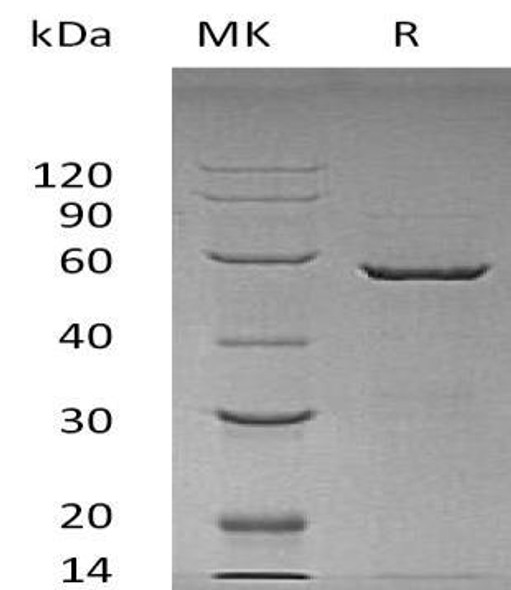Enzymes Recombinant Proteins
Human YWHAE Recombinant Protein (RPPB2682)
- SKU:
- RPPB2682
- Product Type:
- Recombinant Protein
- Species:
- Human
- Uniprot:
- P62258
- Research Area:
- Enzymes
Description
| Product Name: | Human YWHAE Recombinant Protein |
| Product Code: | RPPB2682 |
| Size: | 20µg |
| Species: | Human |
| Target: | YWHAE |
| Synonyms: | YWHAE, MDS, MDCR, KCIP-1, 14-3-3E, 14-3-3 Epsilon, FLJ45465, Tyr-3/Trp- 5 Monooxygenase Activation Protein Epsilon. |
| Source: | Escherichia Coli |
| Physical Appearance: | Sterile filtered colorless solution. |
| Formulation: | YWHAE solution containing 20mM Tris 7.5. |
| Stability: | YWHAE Human Recombinant although stable at 4°C for 1 week, should be stored below -18°C. Please prevent freeze thaw cycles. |
| Purity: | Greater than 95.0% as determined by SDS-PAGE. |
| Amino Acid Sequence: | MDDREDLVYQ AKLAEQAERY DEMVESMKKV AGMDVELTVE ERNLLSVAYK NVIGARRASWRIISSIEQKE ENKGGEDKLK MIREYRQMVE TELKLICCDI LDVLDKHLIP AANTGESKVFYYKMKGDYHR YLAEFATGND RKEAAENSLV AYKAASDIAM TELPPTHPIR LGLALNFSVFYYEILNSPDR ACRLAKAAFD DAIAELDTLS EESYKDSTLI MQLLRDNLTL WTSDMQGDGE EQNKEALQDV EDENQ |
The 14-3-3 family of proteins plays a key regulatory role in signal transduction, checkpoint control, apoptotic and nutrient-sensing pathways. 14-3-3 proteins are highly conserved and ubiquitously expressed. There are at least seven isoforms, �Beta, ?, ?, ?, ?, ? and ?�that have been identified in mammals. The 14-3-3 epsilon, a subtype of the 14-3-3 family of proteins, was thought to be brain and neuron-specific. It has been shown to interact with CDC25 phosphatases, RAF1 and IRS1 proteins, suggesting its role in diverse biochemical activities related to signal transduction, such as cell division and regulation of sensitivity. It has also been implicated in the pathogenesis of small cell lung cancer.
YWHAE Human Recombinant produced in E.Coli is a single, non-glycosylated, polypeptide chain containing 255 amino acids (1-255) and having a molecular mass of 29 kDa. YWHAE is purified by proprietary chromatographic techniques.
| UniProt Protein Function: | Adapter protein implicated in the regulation of a large spectrum of both general and specialized signaling pathways. Binds to a large number of partners, usually by recognition of a phosphoserine or phosphothreonine motif. Binding generally results in the modulation of the activity of the binding partner. Positively regulates phosphorylated protein HSF1 nuclear export to the cytoplasm (PubMed:12917326). |
| NCBI Summary: | This gene product belongs to the 14-3-3 family of proteins which mediate signal transduction by binding to phosphoserine-containing proteins. This highly conserved protein family is found in both plants and mammals, and this protein is 100% identical to the mouse ortholog. It interacts with CDC25 phosphatases, RAF1 and IRS1 proteins, suggesting its role in diverse biochemical activities related to signal transduction, such as cell division and regulation of insulin sensitivity. It has also been implicated in the pathogenesis of small cell lung cancer. Two transcript variants, one protein-coding and the other non-protein-coding, have been found for this gene. [provided by RefSeq, Aug 2008] |
| UniProt Code: | P62258 |
| NCBI GenInfo Identifier: | 51702210 |
| NCBI Gene ID: | 7531 |
| NCBI Accession: | P62258.1 |
| UniProt Secondary Accession: | P62258,P29360, P42655, Q4VJB6, Q53XZ5, Q63631, Q7M4R4 B3KY71, D3DTH5, |
| UniProt Related Accession: | P62258 |
| Molecular Weight: | 26,504 Da |
| NCBI Full Name: | 14-3-3 protein epsilon |
| NCBI Synonym Full Names: | tyrosine 3-monooxygenase/tryptophan 5-monooxygenase activation protein epsilon |
| NCBI Official Symbol: | YWHAE�� |
| NCBI Official Synonym Symbols: | MDS; HEL2; MDCR; KCIP-1; 14-3-3E�� |
| NCBI Protein Information: | 14-3-3 protein epsilon |
| UniProt Protein Name: | 14-3-3 protein epsilon |
| Protein Family: | 14-3-3 protein |
| UniProt Gene Name: | YWHAE�� |






